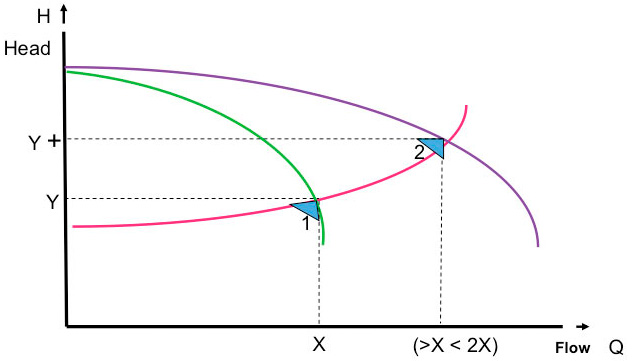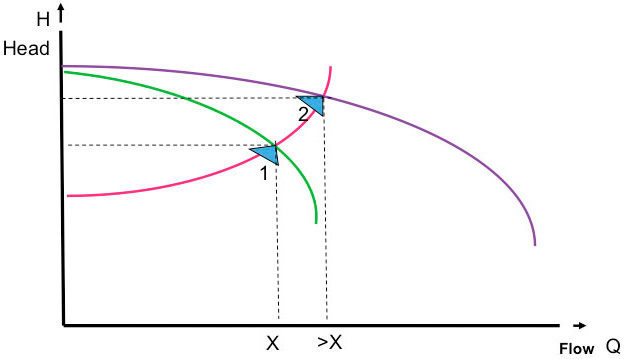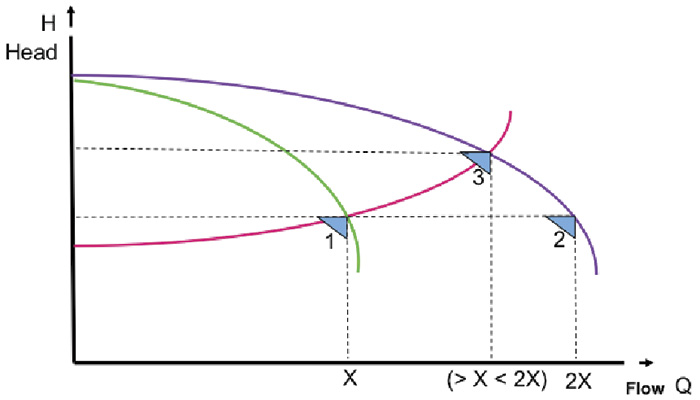I am often asked to visit plant sites to consult on problems regarding inadequate flow rates in two-pump systems. These plants are usually more than 10 years old, and the commissioning operators and engineers are no longer present. Plant output requirements have increased, and/or the equipment is simply old and less efficient. Either way, the desired outcome is to obtain more flow through the system.
In a typical scenario, someone observes there is an additional installed pump and decides the solution is to simply start and operate the second pump. To an untrained person who sees two pumps installed in the same system, it seems logical that operating the second pump in parallel will increase the flow. This may work in some instances but often does not. When the system is not designed for two (or more) pumps to operate at the same time (in parallel), it will not take long for both pumps to experience issues.
If you have a two-pump system, the first step is to determine how the system is designed:
- Two pumps set up to run individually and/or in parallel. In other words, pumps can run in parallel or separately, covering a wide range of expected flows.
- Two pumps set up with one pump as an installed spare.
To find the solution to the problem, the first thing I ask for is the system curve. The curve is often not available, so I work with plant personnel to calculate and develop the system curve. Once we overlay the system curve on the pump curves, the issue and possible solutions become readily apparent.
In many cases, the system designer may have designed the system to have one pump do all of the required work (100 percent duty pump) with a second pump (also known as the redundant pump, installed spare, 100 percent spare or backup pump) ready for operation so the first pump can be removed from service without disturbing the production process. The pumps and their associated motors and controllers are each designed for 100 percent duty.
The intersection of the single pump curve and the system curve should be near the best efficiency point (BEP) for the pump. In these types of cases, the piping system is not designed for both pumps to operate at the same time. The pipe size is typically too small to efficiently handle the higher flows and presents a huge friction loss if both pumps are operated. Another way to think of this situation is the system curve is steep—not flat—for two-pump operation.
If the system is designed for both pumps to operate at the same time, then the system curve will, by design, be flatter overall and present less friction. You can also think of undesired friction as wasted horsepower, which translates to higher electrical costs.
This column is not meant to explain in detail why one curve is steep and the other is flat. The important point to note is the steeper curves represent more friction loss as you attempt to pump more flow through the pipe. For this article, it is sufficient to say that if the system is designed for parallel pumping, the system curve will tend to be flatter.
Figure 1 depicts a properly designed system for parallel pump operations. With one pump operating (Intersection Point 1), the system curve remains relatively flat, and flow is X with corresponding head Y.
 Figure 1. Typical system designed for two pumps to operate in parallel (Graphics courtesy of the author)
Figure 1. Typical system designed for two pumps to operate in parallel (Graphics courtesy of the author)When the second pump is started (Intersection Point 2), the friction presented by the higher flows yields a slightly steeper system curve. While the flow will be more than X, please note that it will not attain magnitude 2X.
Figure 2 shows that if one of the pumps is an installed spare and both pumps are operated at the same time, then the additional flow is too much for the given pipe diameter, and the result is a high friction loss.
 Figure 2. System not designed for two pumps to operate in parallel. The second pump is intended as a spare only.
Figure 2. System not designed for two pumps to operate in parallel. The second pump is intended as a spare only. Looking at Operating Point 2, you can see that starting the second pump has yielded little additional flow. It could be in the range of X flow plus 10 percent, but in many cases it is even worse. This is why starting the second pump can actually kill both pumps.
In these situations, there will always be a strong pump and a weak pump. Even if the pumps were designed and manufactured to be identical, there is always some nuance in one of the pumps and in the system that will prevent the pumps from being identical.
The stronger pump will attempt to take the full load (as presented by the system). The stronger pump will run far right on its curve (a condition called runout) and have issues with vibration and cavitation (net positive suction head [NPSH] and flow angle incidence recirculation) that will manifest as damaged impellers as well as short-lived bearings and mechanical seals. At the same time, the weak pump will run at low to no flow and have similar issues because it is operating at the far left side of the curve. It is not uncommon for the stronger pump to develop sufficient pressure to close the discharge check valve on the weaker pump, consequently forcing it to operate at a shutoff head (zero flow rate).
Figure 3 shows the operation of Pump 1 (Intersection Point 1) and the subsequent parallel operation of Pump 2. A common misunderstanding is that if you start the second pump, the flow rate will double to Intersection Point 2. In reality, the actual operating point will be at Intersection Point 3. In a centrifugal pump system, the pump will always operate where the system curve dictates.
 Figure 3. Common misconception about pumps in parallel: The user expects flow at Point 2 when starting the second pump, but it will actually be Point 3.
Figure 3. Common misconception about pumps in parallel: The user expects flow at Point 2 when starting the second pump, but it will actually be Point 3.10 Tips to Remember
- This article discusses two pumps in parallel, but please note that you can have any number of pumps operating in parallel.
- Pumps in a system that is not designed for parallel operation should not be operated at the same time except for brief intervals during switching operations. To do otherwise is likely to prematurely damage both pumps.
- Often, a good system design is to have pumps in parallel because they can provide flexibility to match the flow to the load. This setup is also more reliable because it provides standby protection for a relatively high percentage of the full load in the event of one pump loss.
- Parallel system designs promote efficiency, because they can better handle a range of flows when compared with using one large pump.
- Different pump designs/models can operate together in parallel, but it is important that they have an identical shutoff head and similar specific speeds.
- If the system is designed for parallel pumps, determine which pump is the stronger one by running one at a time and measuring the head at various flows. As a general rule, always start the weaker pump first.
- You can overcome some of the mismatches in pump and system designs by using variable speed drives and carefully monitoring where each pump is on the curve, changing speeds as required to keep the load balanced.
- When running one pump for small loads and then starting the second pump to pick up larger loads, do not let the first pump run out on its curve too far before the second pump is started. The first pump may be cavitating for some time before the second pump picks up. I see this happen often on systems designed to operate automatically. The designer often overlooks the NPSH margins at the right side of the curve.
- Whether the pumps are in parallel or it is just two pumps in a one-pump system, I always recommend installing hour meters to track the operating hours. I have witnessed many mistakes resulting from decisions based on someone's memory or record-keeping habits. Hour meters are inexpensive insurance. (Do you know when to change the oil in the pump?)
- In a parallel pump system, whichever pump is started first must be capable of covering the full load presented by the system curve without overloading the driver or running out on its own curve.
To read other articles in the 'Common Pumping Mistakes' column, go here.

